Research Program
The advanced system-level hybrid simulation methods have led to various industry and academic collaborations because the simulation methods can improve the accuracy in predicting structural responses subjected to various loading conditions. In addition, because my research group is equipped with a good balance of knowledge in numerical modelling, sensing/instrumentation, structural testing, and integration of these research tools for system-level assessment, we have developed collaborations with diverse research groups. A few selected examples are 1) hybrid simulation of soil-pipe interaction at the University of Patras, Greece, 2) hybrid simulation of as-built and retrofitted steel frame designed in Italy, 3) multi-platform simulation of APR1400 nuclear powerplant for accurate failure mode assessment, 4) hybrid simulation of steel columns and RC columns subjected to fire load, 5) hybrid simulation of a structure subjected to fire following an earthquake event, 6) hybrid wind simulation of bridge decks, etc.
While my group’s forte has been in the hybrid simulation method as summarized above, we are also exploring new research topics. One example is a development of a deep neural network model for response prediction of nonlinear SDOF systems subjected to random vibration. During my research leave, I became familiar with programming with microcontrollers which led to the development of deployable low-cost sensor and data logging systems. In addition, through collaboration with Prof. Bentz in our department, we developed a new strain sensor with adjustable gauge length and designed and implemented a data logger which can record strain and temperature data for several years. We developed a testing method to evaluate the leak rate of compressed air in the concrete containment structures. In addition, we developed an experimental method to measure the shrinkage strain of concrete through thickness of a deep concrete element. My group also developed a numerical procedure with which the temperature-induced strain on the surface of nuclear containment structure can be predicted by modelling solar radiation and environmental condition around a nuclear containment building.
The above is a high-level overview of the research program of my group. For details, please refer to the journal papers, conference proceedings, or students’ thesis. The followings highlight a few recent projects from my research groups.
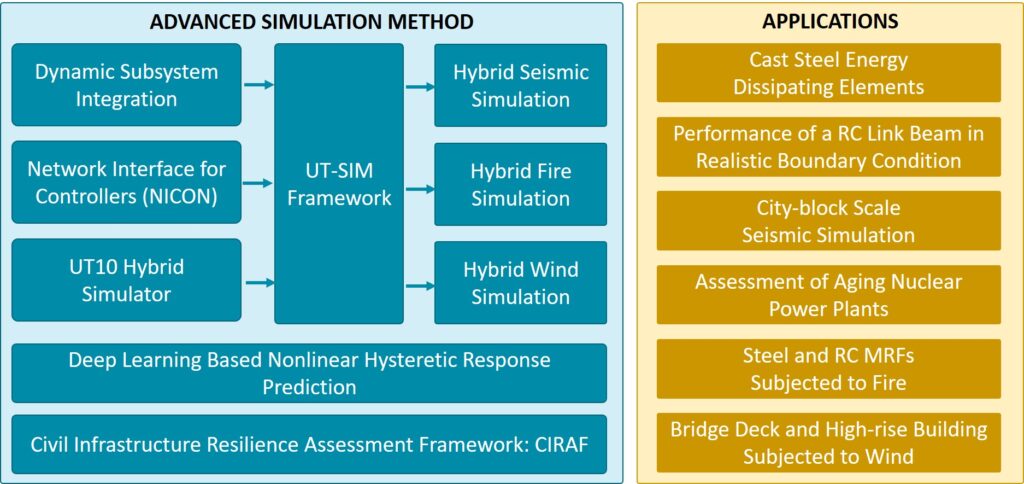
Project Websites
UT-SIM Framework: A framework for multi-platform hybrid simulation
CIRAF: Civil infrastructure resilience assessment framework
ERD2: Seismic demand prediction using deep neural network
EXCHANGE-RISK: Experimental & Computational Hybrid Assessment of Natural Gas Pipelines Exposed to Seismic Risk
HIT-FRAME: Hybrid testing of an existing steel frame with infills under multiple earthquakes
Video clips: Various video clips from Prof. Kwon’s research group
Hybrid Simulation of a Structure Subjected to Fire Load
A hybrid fire simulation was performed on a steel frame structure in which a critical element (i.e. column) was experimentally tested in a furnace and heated with the ISO834 fire curve up to 740°C while the remaining structural system was numerically modelled in ABAQUS. The proposed method is different from previous approaches in that it is fully validated with full-scale specimens subjected to high temperatures and that it is an automated displacement-controlled test with deformation error compensation. The method was recently improved with a continuous real-time algorithm with error compensation to compensate for the deformation of the loading frame during hybrid fire simulation.
Main Contributor: Xuguang Wang, Raymond Ma, Peiying Zhang
Collaborator: Korea Institute of Civil Engineering and Building Technology
Publications: J43, J51, J53, J59, J72, C63, C82
Media:3-minute Thesis Video Competition

Real-Time Wind-Tunnel Hybrid Simulation of Bridge Decks and Buildings
Due to the challenges in numerical simulation of wind-structure interaction, the dynamic response of long-span bridges or high-rise buildings subjected to wind loads has been primarily evaluated through wind tunnel tests. In the aeroelastic wind tunnel test of a bridge deck or a building, the wind force and the interaction between wind and the structure is very difficult to model computationally. Yet, the stiffness, mass, or damping properties can be easily modelled in a computer because they remain nearly constant throughout a wind tunnel test. In our research group, hybrid simulation methods are being developed for aeroelastic wind tunnel tests of a scaled section model of a bridge deck and a high-rise building such that the wind force can be measured in the wind tunnel whereas the dynamic properties are numerically modelled. Both systems were fully developed in 2019. The hybrid simulation apparatus for high-rise buildings was validated in a wind tunnel of the industry partner, Gradient Wind Engineering.
Main Contributor: Moniruzzaman Moni, Jaehong Shim (SNU), Dr. Youchang Hwang (SNU)
Collaborator: Gradient Wind Engineering
Publications: C74, C87, C90, C93, C94, C102, J68
Media:3-minute Thesis Video Competition – Bridge
Media:3-minute Thesis Video Competition – Building
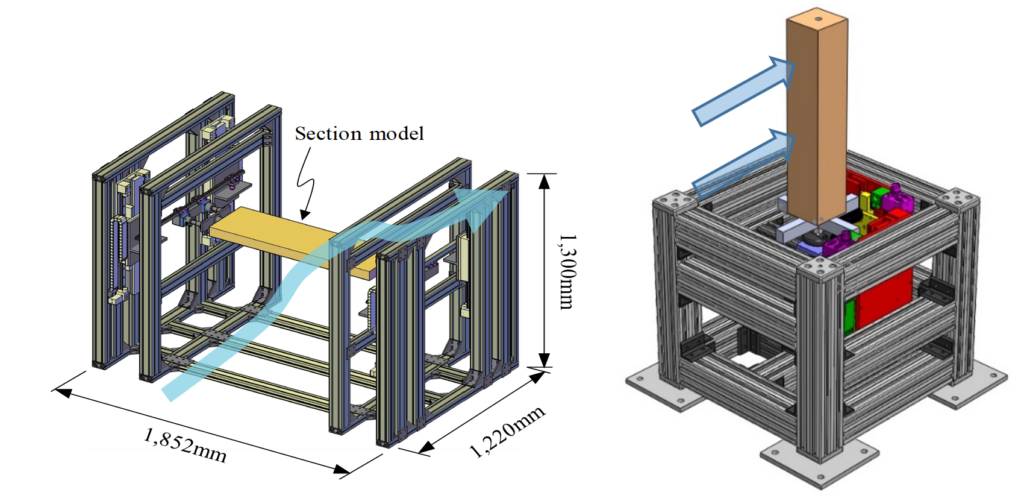
Replaceable Cast-Steel Link Element for Eccentrically Braced Frames
A large experimental program is currently ongoing in the University of Toronto Structural Testing Facilities, in collaboration with Cast ConneX corporation on experimental validation and performance assessment of Cast-Steel Replaceable Links for use in Eccentrically Braced Frames (EBFs). The project aims to develop an off-the-shelf product that when used in EBFs, will dramatically improve the seismic performance of such systems.
In the first phase of the project, the response of the proposed Cast Steel Links will be studied through component-level and frame-level experimental validations. After the experimental validations, the response of steel EBFs with Cast Steel Links will further be studied through several pseudo-dynamic hybrid simulations.
In the second phase, the performance of a mid-rise steel EBF with replaceable cast-steel links will be studied through a set of hybrid simulations. In these experiments, which use the UT-SIM framework, OpenSees will act as the integration module while the response of the cast-steel link on the first floor will be captured physically within an EBF frame.
In the subsequent tests, a set of multi-element, multi-axial hybrid simulations will be carried out on the mid-rise EBF equipped with replaceable cast steel links. In these experiments, OpenSees will act as the integration module while the response of the links will be captured physically.
Main Contributor: Pedram Mortazavi, Eden Lee
Collaborators: Professor Christopoulos; Cast Connex
Publications: C98
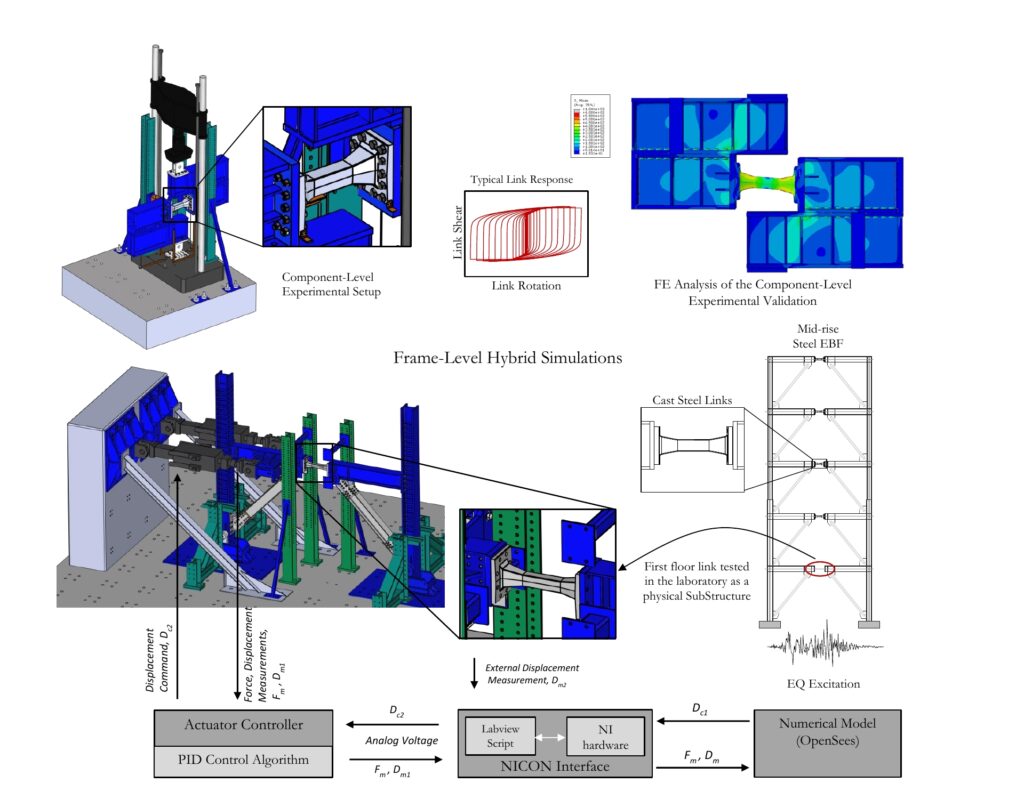
Civil Infrastructure Resilience Assessment Framework
Disruptive events (e.g., earthquakes or floods) causes severe damage to civil infrastructural systems, and there is need to extend the focus of traditional design practices to include resilience-based design techniques which can help in defining preventive actions and measures to mitigate their effect. This study presents a framework to assess the fragility and resilience of a single or interconnected civil infrastructural system following a disruptive event.
Conditional probability tables (CPT) were established to define the probabilistic relationship between different structural and non-structural components of the infrastructure. Bayesian models are used to evaluate the probability of failure of a system, which consists of layers of sub-systems and components. The demand values used in CIRAF for analysis can either be manually defined or extracted from a series of Finite Element analyses or Internet of things (IoT) devices.
A state of the art engineering tool is also developed using the framework that would enable the stakeholders to compare different upgrade strategies through an easy to use web interface. One of the potential application of the CIRAF is to assess the resilience of critical structures such as nuclear power plant. Various resilient strategies can be defined by the stakeholders and an optimized configuration for the nuclear power plant can be defined.
Main Contributor: Tarun Singhal
Collaborators: Professor Bentz; Professor Christopoulos
Publications:C72, J65
Software or project website:www.ut-ciraf.com
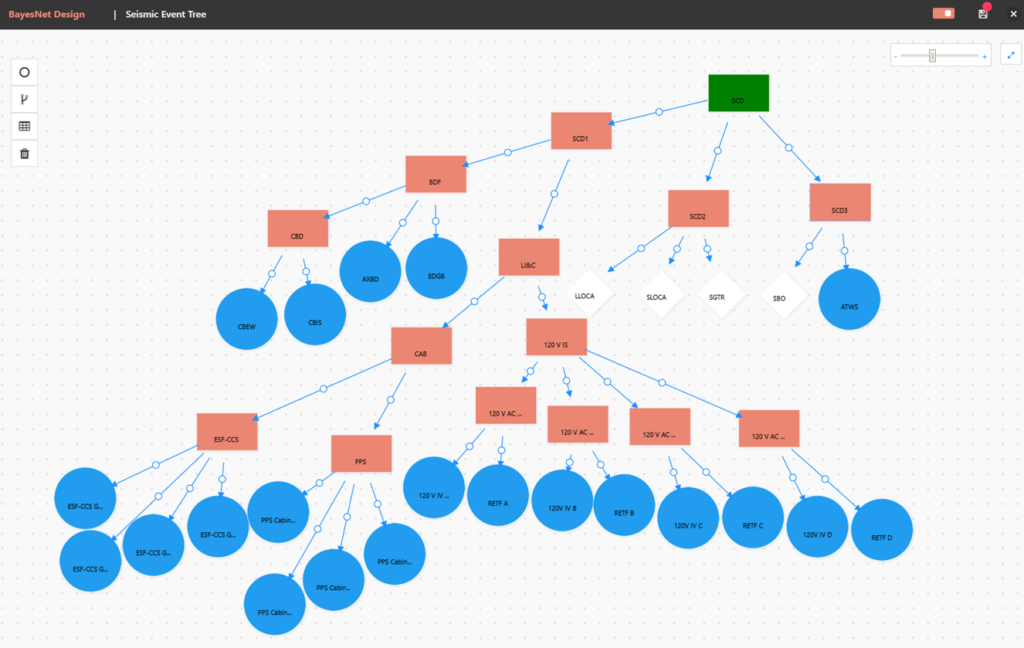
Algorithm for Dynamic Subsystem Integration
The multiplatform numerical simulation method is appealing for seismic performance assessment of large-scale and complex structures. The method allows a structure to be decomposed into several substructures and each of which can be analyzed separately to take advantage of different analysis tools. In most cases, the majority of the system will be modelled in the main program that formulates and solves the equation of motion of the entire system. Then the other substructures contribute to the system equation of motion as interface restoring forces. However, if a large system is decomposed into several subsystems with comparative size and complexity, each subsystem needs to formulate its own equation of motion and run dynamic analysis independently.
A simulation method is being developed to integrate dynamic subsystems modelled with various existing analysis tools. The simulation is initiated from a coordinator which synchronizes the data exchange among different dynamic subsystems. Attributed to the generalized integration algorithm and the communication library implemented in the coordinator, each subsystem can use its own solver and time step for numerical integration.
One of the potential applications of the proposed method is the soil-structure interaction (SSI) analysis of the nuclear containment structure as shown in the figure. Specifically, the soil domain is modelled in OpenSees with detailed material properties while the containment structure is modelled with VecTor4 such that the nonlinear behaviours of both the containment and the soil can be accurately captured.
Main Contributor: Xu Huang, Ph.D.
Publications: J41, J63, C77
Software or project website:www.ut-sim.ca
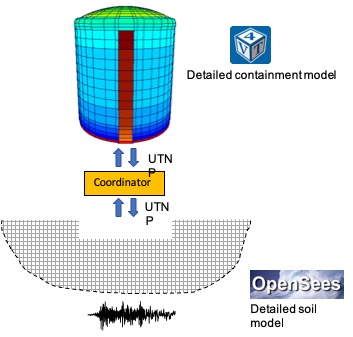
Probabilistic Evaluation of Seismic Response of SDOF Systems Using Deep Neural Network
A new deep neural network model is proposed to predict seismic demands of various SDOF systems as a replacement for an onerous and complex nonlinear time history analysis. Two different information, ground motion and structural system are employed as inputs and predict the maximum structural responses (e.g. displacement, velocity, and acceleration) during an excitation. In particular, the structural information is defined as a cyclic pushover curve which is formatted as two-column data (i.e. displacement and force), then the important features are extracted from the convolutional neural network. Firstly, the proposed model deterministically predicts the structural responses given input ground motion and structural information. Although the method shows superior accuracy compared to the existing nonlinear static procedure such as the coefficient method by ASCE 41-13 or the capacity spectrum method by FEMA 440, it cannot quantify the variabilities stemming from the nonlinear behaviour of the structural system. Thus, secondly, the probabilistic deep neural network model is developed which can predict the mean and standard deviation of the structural responses. The supporting source codes and the interactive visualization web service are available at http://ERD2.snu.ac.kr.
Main Contributor: Taeyong Kim at Seoul National University. Co-supervision.
Collaborator: Professor Junho Song at Seoul National University
Publications: J62, J60, J48, C86, C73, C71, C66, C61

Evaluation of the Thermal Strain of an NPP Containment Structure during Leakage Rate Tests
In this research project, a strategy for isolating the thermal strain due to solar radiation from the total measured strain during the Integrated Leak Rate Test of a nuclear containment structure is developed. In the proposed method, a series of numerical models are developed to estimate the temperature change on the prestressed concrete containment structure and to predict the strain due to temperature and applied pressure. The effects of the solar radiation, heat exchange with internal and external air and heat conduction are considered in the proposed method. The developed method is validated by reproducing the total strain profiles measured from the leak rate tests conducted at the Point Lepreau CANDU®1 6 containment structure. In 2018 the research group also carried out field measuremnet to collect data on heat influx from the sun, environmental conditions, and surface temperature of the nuclear contaimnet structuring during the ILRT.
Main Contributor: Xuguang Wang, Stanley Tiany Cheng
Collaborators: Professor Bentz; Candu Energy Inc.
Publications:C75, J59
Development of UT10 Simulator and Hybrid Simulation of a Five-Story BRBF
Saeid Mojiri’s Ph.D. research project includes two main thrusts: development of a multi-element hybrid simulator, and its application to seismic performance assessment of multi-story braced frames subjected to earthquakes. In order to achieve a realistic seismic response assessment for braced frames, Saeid performed pseudo-dynamic hybrid (experimental-numerical) simulations on steel braced frames with braces tested physically. For this purpose and as part of his research project, Saeid developed a unique experimental apparatus that has been named the University of Toronto’s 10-Element (UT10) Hybrid Simulator which enables hybrid simulations of up to 10 large-scale uniaxial steel braces simultaneously, making it one of the largest number of physical elements used in hybrid simulation applications in Civil Engineering. UT10 Hybrid Simulator is built on the Shell Element Tester (SET) facility at the University of Toronto. SET uses sixty, 500 kN or 1000 kN servo-controlled hydraulic actuators to support and load the brace specimens. MTS FlexTest 200 controllers with over 60 control channels and an AeroPro software are used to control these actuators. Control of this number of actuators and using them for hybrid simulation was a significant challenge for which Saeid had to make modifications in the controllers, program the software interface, and develop a National Instrument LabVIEW based network interface for the hybrid simulations. Thus far, Saeid has successfully used UT10 Hybrid Simulator to perform 1-, 3-, and 4-element hybrid simulations on a 5-storey building equipped with Buckling Restrained Braced Frames (BRBF) and Special Concentric Braced Frames (SCBF). The outcomes of his experimental programs can be used for critical review and potential improvements of the currently used modelling techniques and performance based design guidelines for multi-storey high performance braced frames.
Main Contributor: Saeid Mojiri, Ph.D.
Collaborators: Professor Christopoulos
Publications: J50, C59, C43, C42
Seismic Performance of Cast Steel Yielding Connector
Steel castings have been increasingly used in building construction to enhance the seismic resistance of structures. Such castings are designed as yielding fuses that dissipate energy through large inelastic deformations, while the rest of the structure remains mainly elastic. Typically, the governing ultimate limit state of these yielding fuses is their ultralow-cycle fatigue (ULCF) life. A large experimental research program is conducted in the University of Toronto Structural Testing Facilities, in collaboration with Cast Connex corporation on the experimental and numerical characterization of Ultralow-Cycle Fatigue (ULCF) behaviour of steel castings.
This program consists of tests and finite-element analyses of small-scale coupons and full-scale tests of a variety of cast steel yielding connectors (YC)—devices that dissipate seismic energy through the inelastic deformation of cast steel triangular yielding fingers. The experimental testing program evaluates the performance of YC in accordance with the requirements of ASCE/SEI 41-17 through eight full-scale YC component and brace subassembly tests. In addition, nine full-scale ULCF tests on YC, and twenty cyclic notched coupon tests are performed to assess the ULCF life of steel castings. Research outcomes include modelling improvements over previous numerical models of yielding connectors, an optimized material calibration procedure using an automated optimization algorithm and a device-specific ULCF model calibration process, the use of the stress-weighted damage model for fracture prediction that considers the Lode parameter along with the stress triaxiality, use of the calibrated material model as a design tool for prototype development of a new cast steel replaceable link, and a post-fracture simulation scheme for numerical simulation of the entire ductile fracture process of YC and other similar yielding connectors. Further, the advanced material and FE model developed in this research program is being used as a tool for progressive collapse analysis to numerically assess the ultimate performance of structures designed with the cast steel YC.
Main Contributor: Chiyun Myron Zhong, Pedram Mortazavi
Collaborators: Professor Christopoulos; Cast Connex
Publications: J64, J55, C67, C95, C97, C100
Media:3-minute Thesis Video Competition
Buried Steel Natural Gas Pipelines under Spatially Variable Earthquake Ground Motion
As part of the mission of an intercontinental consortium of academic and industrial partners in the framework of the EXCHANGE-Risk project, we set to identify the dominant failure modes of buried steel gas pipelines under seismic wave propagation, and investigate by analytical and experimental means the critical conditions, including soil material state and soil-pipe contact, that can lead to such damage.
In view of the well-established findings that pipeline seismic response in homogeneous soils is rarely significant, the focus was placed on cases of spatial variability of seismic ground motion. The damage potential of spatially variable seismic ground shaking to buried pipelines has long been confirmed by field evidence, with one of the principal failure modes being shell buckling in axial compression. A numerical approach was taken to analyze the elastic-plastic buckling response of buried steel natural gas pipelines subject to transient compressive axial ground strains arising from strong lateral site inhomogeneities. The sub-structured, two-phase analysis involved the computation of pipeline input excitation from 2D linear viscoelastic and linear-equivalent seismic site response models and the quasi-static application of the derived critical motion profiles on a near-surface 3D continuum soil model surrounding an extended inelastic shell model of the pipeline.
A parametric study was carried out to identify the ground and exciting conditions bearing adverse effects on the peak pipeline response. The impedance contrast of the site is shown to govern the level of induced elastic strains, which are maximized for low-frequency excitations.
Furthermore, by comparing the pipeline demand in terms of stress and strain to capacity metrics prescribed in present seismic codes, the importance of the local site response was gauged. Even though pipeline axial strain demand-to-capacity ratios for elastic local site response under weak excitation imply a large safety margin, pipeline demand can exceed capacity near the site boundary under strong excitations and subsequent nonlinear soil response.
Overall, it was demonstrated that the seismic vibrations of certain inhomogeneous sites can produce appreciable axial stress concentration in the critically affected pipeline segment near the material discontinuity, enough to trigger coupled buckling modes in the plastic range. This behaviour was found to be controlled by strong axial load-moment interaction, a behaviour not reflected in code-prescribed limit states.
Main Contributor: Nick Psyrras
Collaborators: Professor Sextos at the University of Bristol; Professor Gerasmidis at University of Massachusetts Amherst
Publications: J47, C68
